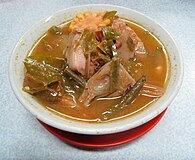 Sayur asem | |
| Course | main course |
|---|---|
| Place of origin | Indonesia [1] |
| Region or state | Jakarta, West Java, Banten |
| Associated cuisine | Southeast Asia |
| Serving temperature | hot and room temperature |
| Main ingredients | various vegetables in tamarind soup |
Sayur asem or sayur asam is an Indonesian vegetable soup. It is a popular Southeast Asian dish originating from Sundanese cuisine, consisting of vegetables in tamarind soup. [2]
Contents
The sweet and sour flavour of this dish is considered refreshing and very compatible with fried or grilled dishes, including salted fish, ikan goreng , ayam goreng and lalapan , a kind of vegetable salad usually served raw but can also be cooked, and is usually eaten with steamed rice and sambal terasi chili paste.
The origin of the dish can be traced to the Sundanese people of West Java, Banten, and the Jakarta region. It is well known to be a part of the Sundanese cuisine and the Betawi daily diet.

